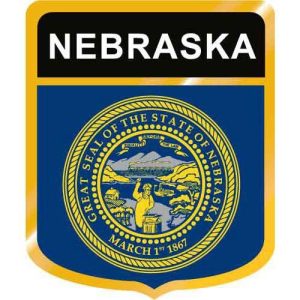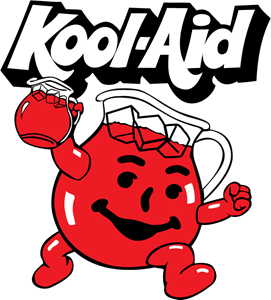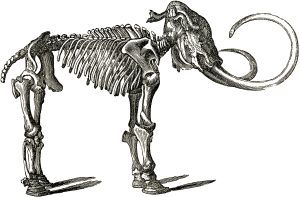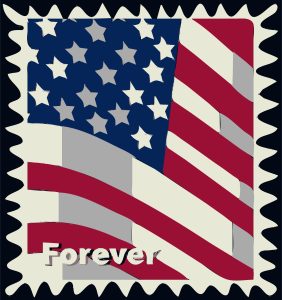Nebraska is a study in contrasts in a way. The area was originally described as the Great American Desert before it became our 37th State in 1867. Like a lot of midwestern states, the area came under the ownership of the USA as part of the Louisiana Purchase in 1803. The final boundaries of what would become Nebraska were not settled until 1854. Nebraska then took 13 years to become a State, but this was not the only thing they were a little slow about. Nebraska adopted a State seal in 1867. They followed that up with adopting a “state banner” in 1925. They didn’t get around to making it the official State flag until 1963.
They followed that up with adopting a “state banner” in 1925. They didn’t get around to making it the official State flag until 1963.
The name Nebraska comes from an Otoe or Otto or Oto (or probably just about anything else with “o” and “t”s) Indian word “Nebrathka” meaning flat water. This referred to the Platt River which runs through the State. Or maybe the Otoe knew that the area also boasts the largest fresh water underground aquifer in the Continental US! Nebraska also claims to have more miles of rivers than any other State. Nebraska claims to have more than 70,000 miles of rivers. I find that one a little suspect myself, unless there are a lot of little rivers hiding out amidst the trees. I mean, how do you reconcile the great American desert with the most miles of rivers?
 So, how did Nebraska go from the great American desert to the cornhusker state? Short answer – it didn’t. At least not directly. After being known as the GAD, Nebraska became the “Tree Planter’s State”. This might be partially the fault of one Julius Sterling Morton. In 1872 he had the idea that what we all needed was a holiday where everyone would forego their usual work and spend the day planting trees instead. The first such holiday was observed on April 10, 1872 with the planting of more than one million trees. Thus, you can blame Nebraska for Arbor Day, a holiday just about no one celebrates anymore, with the sole exception of the USPS who usually issue some sort of a stamp with trees on it. Morton’s original idea for the holiday included prizes for individuals and communities that planted the most trees. I was not able to find out what the prizes were and if there were also any 50/50 drawings. In 1885 Nebraska moved Arbor Day to April 2nd, which was also Mr. Morton’s birthday. National Arbor Day is the last Friday in April each year, but to keep it interesting many States have their own dates for Arbor Day each year, supposedly to account for different planting seasons. Personally, I think it is all the fault of Hallmark so they can continue to kill trees to create more and more greeting cards for holidays that no one really cares about.
So, how did Nebraska go from the great American desert to the cornhusker state? Short answer – it didn’t. At least not directly. After being known as the GAD, Nebraska became the “Tree Planter’s State”. This might be partially the fault of one Julius Sterling Morton. In 1872 he had the idea that what we all needed was a holiday where everyone would forego their usual work and spend the day planting trees instead. The first such holiday was observed on April 10, 1872 with the planting of more than one million trees. Thus, you can blame Nebraska for Arbor Day, a holiday just about no one celebrates anymore, with the sole exception of the USPS who usually issue some sort of a stamp with trees on it. Morton’s original idea for the holiday included prizes for individuals and communities that planted the most trees. I was not able to find out what the prizes were and if there were also any 50/50 drawings. In 1885 Nebraska moved Arbor Day to April 2nd, which was also Mr. Morton’s birthday. National Arbor Day is the last Friday in April each year, but to keep it interesting many States have their own dates for Arbor Day each year, supposedly to account for different planting seasons. Personally, I think it is all the fault of Hallmark so they can continue to kill trees to create more and more greeting cards for holidays that no one really cares about.
Possibly relating to Nebraskans’ love of trees, the State is also home to The Henry Doorly Zoo in Omaha, Nebraska, which houses the largest indoor rainforest in the United States. Called The Lied Lunge, it covers 1.5 acres with an 8-story building that features flora, fauna and animals from rainforests all over the globe. Nebraska also boasts the largest hand-planted forest in the world. The Halsey National Forest near Thedford has that distinction. I was not able to get a confirmed count on how many trees it contains, or how many were planted on Arbor Day. (Okay, no more about Arbor Day, I promise)
In 1945 Nebraska became officially tired of the whole tree thing and changed their motto to the cornhusker state. This is probably for the best as I doubt that the University of Nebraska Tree Planters football team would rack up 27 consecutive winning seasons and bowl appearances. Cornhuskers football is a big deal in the State, a very big deal. In fact, on game days the University of Nebraska’s football stadium holds more than 90,000 spectators, making it the third most populated place in the State!
So, what else can we thank Nebraska for? You might be surprised. The powdered drink Kool-Aid was perfected by Edwin Perkins of Hastings Nebraska in 1927. But did you know Kool-Aid was not always a powdered drink? Perkins’ original drink was a syrup named “Fruit Smack”. Changing to a powdered form made it a lot easier to package, store and sell. Not to mention I don’t think any of us would have been allowed to set up “Fruit Smack” stands when we were kids to sell each other cups of the stuff on hot days. And just imagine a 6-foot-tall giant pitcher of Fruit Smack crashing through a wall to provided refreshment? Doesn’t have the same benign feel, does it? By the way, Kool-Aid became the official soft drink of Nebraska in 1998.
While the first 9-1-1 telephone call was made in the South (Alabama is the most frequent claimant to those bragging rights), the modern system of linking services via a 9-1-1 call was pioneered in the late 1980s in Nebraska. Pretty sure that one is catching on.
In 1925 an Omaha grocer needed to feed hungry players at a poker game, it was his turn to bring the food, I guess. So, he put together some sandwiches with corned beef and Swiss on rye bread and brought them to the game. One of the players liked them so much he added them to the menu in the restaurant of his hotel. I was unable to find who should be credited with the sauerkraut or the grilling. And how did it get the name? Easy, the grocer was Reuben Kulakofsky. I am glad it was his first name that stuck to the sandwich.
The strobe light was invented by an Aurora, Nebraska man named Harold Edgerton.
Want to hit some of the unique sites in Nebraska? Well once you have explored that tropical rainforest be sure to check out “carhenge”. The 38-automobile structure that recreates the Stonehenge ruins in England can be found just north of Alliance, Nebraska.
 The world’s largest mammal fossil is on display at the University of Nebraska State Museum. This fossil of a Columbian mammoth was unearthed in 1925 in Lincoln County.
The world’s largest mammal fossil is on display at the University of Nebraska State Museum. This fossil of a Columbian mammoth was unearthed in 1925 in Lincoln County.
Want to commemorate “fine” dining? Be sure to check out the 6-foot-tall statue of Chef Boy-ar-dee in Omaha.
in Omaha.
And who could pass up the chance to see the world’s largest “stamp ball”? This tourist attraction was created between 1953 and 1956 and is reputed to contain more than 4,500,000 canceled stamps. People come from all over the world to touch it (why?) or  have their picture taken with the huge ball of used paper and spit, but anyone hoping to add another stamp to the ball will be disappointed. That is strictly forbidden, not to mention it weighs more than 600 pounds. So, head on out to the Boys Town (yes, the one made famous in the movie) and visit the Visitors’ Center to get a good look at the fruits of the Boys Town stamp collecting club.
have their picture taken with the huge ball of used paper and spit, but anyone hoping to add another stamp to the ball will be disappointed. That is strictly forbidden, not to mention it weighs more than 600 pounds. So, head on out to the Boys Town (yes, the one made famous in the movie) and visit the Visitors’ Center to get a good look at the fruits of the Boys Town stamp collecting club.
And while Nebraska is nowhere near any ocean, you can visit a lighthouse along a road in Ashland (which also has a large lake nearby). Being a land-locked State, you might be surprised to learn that Nebraska has a NAVY! (I know I was). It was created in 1931 by Governor T.W Metcalfe. He wanted to give his friends some meaningless government appointments. Over the years the top rank of Admiral of Nebraska’s Navy has been awarded to people who have constantly contributed to the development of the state. Some of the folks named include John Glenn, Bill Murray, Big Bird, and Captain Kangaroo among others.
Finally, a few of the legal quirks of Nebraska:
“No person who is afflicted with a venereal disease shall marry in this state.” This could be a problem for the 1,417 people with reported cases of gonorrhea in 2006, according to Centers for Disease Control and Prevention’s Division of STD Prevention.
It is illegal to pilot a plane while drunk.
It is illegal to go whale fishing in Nebraska (which would be quite a feat as it is landlocked).
In Lehigh it is illegal to sell donut holes. I have to assume either there are no Dunkin Donuts in Lehigh, or no one enforces this one.
In Waterloo it is illegal for barbers to eat onions between 7 am and 7 pm.
Also from Waterloo, no female wearing a “hat which would scare a timid person” can be seen eating onions in public. Waterloo clearly has an issue with onions.
In Lincoln in 1989 it became illegal for “Any person who is diseased, maimed, mutilated, or in any way deformed, so as to be an unsightly or disgusting object, or an improper person to be allowed in or on the streets, highways, thoroughfares or public places in this city, shall not therein or thereon expose himself or herself to public view, under the penalty of a fine of $1 for each offense.”
In Nebraska only doctors may distribute condoms.
But I think my favorite has to be the law that requires drivers on mountains should drive with caution near the right edge of the highway. Why is this my favorite? Because there are no mountains in Nebraska.



